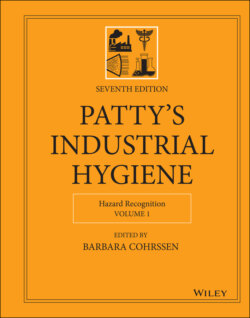Читать книгу Patty's Industrial Hygiene, Hazard Recognition - Группа авторов - Страница 108
2.2 Occupational Safety
ОглавлениеDifferent from IH, which focuses on exposure and control of exposure, OS has accident scenarios and barriers to reduce or eliminate potential accidents. Barriers are to OS as exposure controls are to IH, with examples like fall arrest systems or ground fault circuit interrupters (GFCI) that can both help stop hazardous energy that lead to accident scenarios like falls from heights or electrocution. Safety professionals are also concerned with the full array of potential workplace hazards, however, the profession has traditionally focused on the prevention of traumatic events that can lead to injuries and workplace fatalities. Although historically focused on the prevention of acute traumatic injury, a broader definition includes controlling hazards and the prevention of accidents that protect the workforce while also protecting the general public and the environment. Therefore, the broad discipline of safety deals with the interaction between people and providing the barriers necessary to prevent the acute or chronic outcomes that can adversely impact their well‐being. The discipline of safety is the systematic application of principles drawn from engineering, physics, education, psychology, health, enforcement, and management to prevent harm to people, property, and the environment. The physical aspects of the workplace and their interaction with the worker is an essential part of the safety professional's purview. This includes focusing on preventing potential injuries caused by slips and falls or by being struck by or crushed under an object, cuts, crushes, burns, electric shock, or improper lifting, bending, or stretching and may also include addressing the use of flammable and/or exploding chemicals in production processes.
As with IH, OS training and professional development often do not include the methods of proper and sustainable communication of the risks present within a given workplace. However, there is an advantage for safety professionals when it comes to the discussions with workers' about the adverse outcomes inherent in industry and manufacturing and the methods to provide barriers to prevent these scenarios from occurring. As an example, if an employee loses a finger in a carpenter shop as an outcome of improper use of a saw, the OS professional will have the full attention of the workers the next day as they can immediately understand that they do not want to lose a finger. Acute traumatic events like this can also include electrical shocks, falls from elevation, machinery mishaps, back injuries, and burns to name just a few. As the outcomes of events like these are immediate and often severe, the opportunity to communicate the risks involved and to inject methods of prevention to the workforce is more likely to be maximized and retained. In the absence of a traumatic injury as a precursor to a safety professional's discussion of hazards, risks, and control barriers to employees, the potential to be in a difficult risk communication position is like the one found for the IH profession. In this situation, both professions need to find an appropriate strategy to ensure workers understand the potential for hazards posing a high risk that requires a consistent implementation of controls is essential. Even if the harm these hazards cause might not be imminent or are considered an intrinsic and accepted component of the work, the audience needs to be sufficiently educated as an outcome of the discussion to ensure the necessary controls are consistently used in their workplace.
